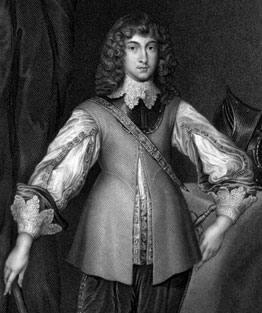Prince Rupert

Prince Rupert
Prince Rupert was born on 17 December 1619, the third son of the Elector Palatine Fredrick V and Princess Elizabeth, daughter of James I and sister of Charles I. Fredrick was offered the crown of Bohemia in August 1619 by rebels there opposed to the religious reforms of the Holy Roman Emperor Ferdinand I, who had succeeded to the Bohemian throne that year. Fredrick accepted and was crowned King of Bohemia in November 1619. But the Emperor garnered support from the Catholic League and the Habsburg family and Fredrick’s army was defeated outside Prague at the battle of the White Mountain on 8 November 1620. Fredrick and his family fled Bohemia, almost leaving the infant Rupert behind, eventually settling in The Hague in April 1621. Rupert grew up there and at Leiden.
He had a reputation for being headstrong and badly behaved, but was something of a child prodigy and interested in all matters military. In 1633, at the age of thirteen, he joined the Dutch army besieging Rheinberg and during the 1635 campaign fought as a trooper in the lifeguard of the Stadtholder, Fredrick Henry, at the sieges of Tirlemont and Louvain. In 1636 Rupert visited England at the behest of his elder brother, Charles Louis, who had become Elector Palatine following their father’s death in 1632. During the visit Rupert met his uncle, Charles I. Returning with his brother to The Hague in 1637 to help raise an army to recover the Palatinate, Rupert served at the siege of Breda while the army was being assembled. In 1638 he marched with the small army raised by Charles Louis to recover his homeland, but was captured by Imperial troops in an action near the river Weser between Lemgo and Vlotho. Rupert was imprisoned in Linz in Austria for the next three years, but was released in late 1641, following pressure from Charles I.
Rupert returned to England in February 1642, but left again almost immediately for the Netherlands, to help Queen Henrietta Maria procure arms and men for the king. Rupert sailed once more for England in August 1642 to take-up the appointment of General of Horse in Charles’s army. The wording of Rupert’s commission was such that he was required to take orders only from the king, a cause of future friction in the royalist high command.
In September 1642 at Powick near Worcester, Rupert commanded in a small cavalry action which resulted in the rout of parliamentarian horse and sealed his and the royalist cavalry’s battle-winning reputation in the early stages of the war. The royalist army had been formed at Shrewsbury that autumn, and in October began its march on London. It was forced to engage the parliamentarian army under the Earl of Essex at the battle of Edgehill. Here Rupert supported Field Marshal Patrick Ruthven in an argument with the king’s senior general, the Earl of Lindsey, about the deployment of the royalist army. This resulted in Ruthven’s preferred ‘Swedish’ style being adopted for the battle; Lindsey effectively resigned his position and, fighting as an infantry colonel, was killed in the battle. Rupert commanded the right wing of the cavalry, which routed the opposing parliamentarian cavalry, but failed to control the horse, which went on to loot the parliamentarian baggage train, leaving the royalist infantry unsupported and the battle resulted in stalemate.
The royalists were able to continue their advance towards London along the Thames valley, with Rupert’s cavalry riding two or so days ahead of the rest of the royalist army, raiding into north-west Surrey during early November. Returning to the king’s headquarters at Colnbrook by 10 November, Rupert rode with the army as it advanced on London, commanding the horse during the battle at Brentford on 12 November and at Turnham Green on the following day.
For much of the early part of 1643 Rupert probed parliamentarian garrisons in the counties to the south and east of Oxford. One such expedition resulted in the death of the leading parliamentarian statesmen and soldier, John Hampden, at Chalgrove in June. Rupert subsequently commanded the royalist forces that captured Bristol in July 1643 and took part in the abortive siege of Gloucester and the subsequent Newbury campaign. In March 1644, Rupert was ordered to relieve Newark and then moved north to the royalists’ northern stronghold at York, which was besieged by three parliamentarian armies. After capturing Liverpool and Bolton and ending the siege of Lathom House in Lancashire, Rupert crossed into Yorkshire and, in a tactically adept move, relieved York from the north. The parliamentarian armies at first retreated, but returned and decisively defeated Rupert in the biggest battle of the Civil Wars at Marston Moor outside the city on 2 July.
In November 1644 Rupert was appointed Lord General of the royalist army, taking over the role from Patrick Ruthven, the Earl of Forth. Rupert was energetic in attempting to rebuild royalist forces in the early part of 1645 and was with the king when the royal army was defeated by parliament’s New Model Army at Naseby in June 1645. Court-marshalled, but cleared, over his surrender of Bristol in September 1645, Rupert left England for the continent in early July 1646.
Between 1648 and 1653 Rupert served the Prince of Wales (Charles II from 1649) as a royalist naval commander, harrying English merchantmen. At the restoration in 1660, Rupert returned to England and was granted a pension by Charles II. He served as joint commander of the English fleet during the Second Anglo- Dutch War (1665-67) and was appointed First Lord of the Admiralty in 1673, during the Third Anglo-Dutch War (1672-74), a post he held until 1679. Rupert died on 29 November 1682 in London and was buried at Westminster Abbey.
